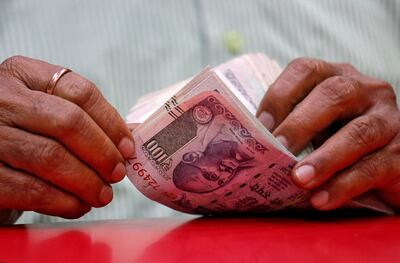The much-anticipated decision by JP Morgan to include Indian government bonds in its widely tracked benchmark emerging markets bond index is spurring investor confidence in Asia's third-largest economy.
The move is expected to potentially bring billions of dollars of foreign inflows into India's $1 trillion government debt market.
JP Morgan on Friday announced that India's local bonds will be included in its Government Bond Index-Emerging Markets, from June 28 next year.
“India's weight is expected to reach the maximum weight threshold of 10 per cent in the GBI-EM Global Diversified, and approximately 8.7 per cent in the GBI-EM Global index,” JP Morgan said.
It said 23 Indian government bonds with a total value of $330 billion are eligible.
“This inclusion will deepen the bond market in India,” said Nilesh Shah, managing director of Kotak Mahindra Asset Management Company.
The move comes as companies and investors are seeking alternatives to China and as some of India's emerging market peers have become less appealing.
“With the exclusion of Russia and troubles in China, the options for global debt investors have narrowed down,” said Mr Shah.
Analysts say the move also signals the growing importance of India as a market for international investors.
“Index inclusion comes at a time when India seems to be stepping on to the world’s stage with more confidence,” said Jennifer Taylor, head of emerging market debt at State Street Global Advisors.
Once India is added to the index from June, “India could expect to receive close to $24 billion in foreign inflows over a 10-month period”, said Sandip Raichura, chief executive of retail broking and distribution and a director at Prabhudas Lilladher, a financial services company based in Mumbai.
“In fact, foreign portfolio investors are already entering the Indian fixed income market in anticipation of this inclusion.”
He said that JP Morgan's addition “is considered a major positive” because it would absorb more than 15 per cent of the net supply of government securities (G-Secs) for the next financial year, which runs from April 2024 to March 2025.
“Furthermore, it is expected to reset historical spreads by 20 to 25 basis points downwards, resulting in a lower capital cost of borrowing for India,” Mr Raichura added.

“Additionally, the increase in forex reserves will contribute to an improved external fundamental situation for the country.”
It has, however, not been an easy process for India to be included in the index. India began talks on having its debt included in global indexes back in 2019. However, it could not materialise due to India’s restrictions on foreign investments in its domestic debt market.
The following year, the Indian government introduced bonds that could be fully owned by foreign investors. These bonds were free from any foreign investment restrictions which made them eligible for inclusion in global indexes.
Indian bond markets and the rupee reacted favourably to JP Morgan's announcement.
The rupee strengthened to trade 0.19 per cent higher against the US dollar at 82.93 during late afternoon trade on Friday.
Experts expect the development to give the currency and bonds a further boost.
“The announcement to include India’s bonds in the GBI-EM index will support both India bonds and local currency,” said Churchil Bhatt, executive vice president and debt fund manager at Kotak Mahindra Life Insurance Company.
“We expect 10-year government bond yields to settle comfortably below 7 per cent as we inch closer to the Index inclusion date.”
JP Morgan's move could lead to India's addition to other indexes, he added.






